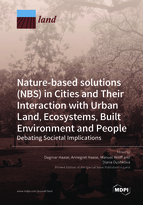Nature-based solutions (NBS) in Cities and Their Interaction with Urban Land, Ecosystems, Built Environment and People: Debating Societal Implications
A special issue of Land (ISSN 2073-445X).
Deadline for manuscript submissions: closed (31 May 2021) | Viewed by 101867
Special Issue Editors
Interests: land-use change modelling; ecosystem services; socio-environmental justice; urban land teleconnections; urban ecology; GIS and remote sensing
Special Issues, Collections and Topics in MDPI journals
Interests: sustainable urban development; urban transformations; urban shrinkage and regrowth; socio-spatial and socio-environmental processes in cities; inequality and justice challenges
Special Issues, Collections and Topics in MDPI journals
Interests: sustainable urbanization; green infrastructure; shrinkage; regrowth; European spatial development
Special Issue Information
Dear Colleagues,
Nature-based solutions are a comparatively new field of research regarding the ‘green city’ and a main focus of large European and Global research programs. Nature-based Solutions (NBS) are defined by IUCN as “actions to protect, sustainably manage, and restore natural or modified—in our case urban—ecosystems that address societal challenges effectively and adaptively, simultaneously providing human well-being and biodiversity benefits”. NBS have the aim to support the achievement of society’s development goals and human well-being and public health as well as social welfare in ways that reflect the cultural and societal values of the urban societies and enhance the resilience of ecosystems, their capacity for renewal, their diversity, along with the provision of services. NBS are designed to address major societal challenges related to cities, such as safe and clean housing, fresh air, food security, climate change, water supply, human health, and disaster risk. NBS are intended to produce societal benefits in a fair and equitable way, thus promoting transparency and broad participation as well as learning and education.
This Special Issue seeks to provide a state of the art of the functional, empirical, and field study-based experiences and data on NBS provided by green and blue infrastructure (GBI) in cities. We focus on the interaction of the instrument of NBS, its benefits, and tradeoffs with urban land, the built environment in cities, and the urban society, in particular in relation to social wealth and public health, also taking into account stewardship and governance aspects.
We aim at answering questions such as:
- What type of GBI-based NBS are being implemented in cities across the Globe?
- Which properties of urban nature and/or urban ecosystems do they make use of, and how do NBS themselves influence urban ecosystems and ecosystem services flows in Cities?
- What are the trade-offs of NBS with other ecosystem services and urban biodiversity?
- What are the typical land units and types where NBS are implemented?
- How do NBS and their implementation interrogate/interact with the social environment and issues of social cohesion and justice?
- What are land governance and policy schemes for NBS in cities? Do they differ from the prevailing land management and governance policies implemented so far in our cities?
- How does the implementation of NBS correspond/interact with general directions and priorities of urban development?
- More specific topics or questions could be added here.
Prof. Dagmar Haase
Dr. Annegret Haase
Dr. Manuel Wolff
Dr. Diana Dushkova
Guest Editors
Manuscript Submission Information
Manuscripts should be submitted online at www.mdpi.com by registering and logging in to this website. Once you are registered, click here to go to the submission form. Manuscripts can be submitted until the deadline. All submissions that pass pre-check are peer-reviewed. Accepted papers will be published continuously in the journal (as soon as accepted) and will be listed together on the special issue website. Research articles, review articles as well as short communications are invited. For planned papers, a title and short abstract (about 100 words) can be sent to the Editorial Office for announcement on this website.
Submitted manuscripts should not have been published previously, nor be under consideration for publication elsewhere (except conference proceedings papers). All manuscripts are thoroughly refereed through a single-blind peer-review process. A guide for authors and other relevant information for submission of manuscripts is available on the Instructions for Authors page. Land is an international peer-reviewed open access monthly journal published by MDPI.
Please visit the Instructions for Authors page before submitting a manuscript. The Article Processing Charge (APC) for publication in this open access journal is 2600 CHF (Swiss Francs). Submitted papers should be well formatted and use good English. Authors may use MDPI's English editing service prior to publication or during author revisions.
Keywords
- Nature-Based Solutions
- cities
- benefits
- trade-offs
- urban land
- ecosystems
- built environment
- urban society








